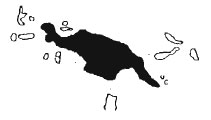Varanus Prasinus
Schlegel 1839.emerald monitor, green tree monitor.
 |
V.prasinus was first described as Monitor viridis by Gray in 1831. According to Sprackland (1990) Gray's type specimen is lost. but according to Brandenberg (1983) it is probably RMNH 4812 in the Leiden Museum. the same specimen described by Schlegel eight years later.
One of the prettiest and most endearing monitor lizards is this little gem from New Guinea An inhabitant of the rainforests. the emerald monitor is superbly adapted to an arboreal existence. Its cryptic colour varies from an intense turquoise green to black depending on its surroundings and its tail is used as a very precise and dextrous extra limb. The soles of the feet possess enlarge dark scales that may aid the lizards when climbing (Czechura 1980, Greene 1986). Like all the monitor lizards of New Guinea. details of their ecology remain a secret. They are found throughout the lowlands of New Guinea, except possibly for the swamps of the south, and on many islands. Location data can be found in Brandenberg (1983) and Sprackland (1990).
Emerald monitors, as their name suggests, are green, but usually have some black pattern. The degree of patterning varies, with some specimens unmarked and other covered in a thick. black reticulum. Animals which are entirely black and have keeled (almost spiny) scales on the neck are probably V.bogerti or V.beccarii.
The emerald monitor inhabits rainforests, palm forests, mangroves and cocoa plantations (Cogger 1964; Room 1974; Czechura 1980) and have only been seen in trees or on vines. According to Sprackland (1990) they reach a total length of 100cm. A specimen examined by Room (1974) from Pond etta in northern Papua measured 30cm SVL with a damaged tail. A captive specimen grew from 28cm TL to 30.8cm TL in six months (Sprackland 1989). Their food appears to consists mainly of large tree dwelling insects such as katydids, together with other orthopterans, huge armoured stick insects, roaches, beetles, centipedes, spiders and the occasional small mammal (Greene 1986). Before swallowing the formidable stick insects the lizards tear off some of their spinier legs. Although they eat mainly small prey they appear able to swallow mammals of a considerable size; a 135g lizard contained the remains of a 40g rodent (Greene 1986). The emerald monitor lays its eggs in arboreal termite nests (Allen (in Greene 1986), Allison, pers. conun). Hatchlings have been collected in October and may feed on termite or their eggs.
The prasinus type monitors were considered to be dwarf monitors of the Odatria type by Mertens (1942). However in many aspects of their morphology they more closely resemble the inidcus-type lizards. Sprackland (1989) describes bipedal ritual combat which occurs in trees rather than on the ground. He also notes that emerald monitors appear to defend their tails rather use them for defence when threatened. The tail is clearly too fine a tuned organ to be used as a whip. Eidenmuller (pers. conun.) considers that females are comparatively rare amongst imported animals. Brandenberg (1983) found that 14 of 23 specimens examined by him were males.
This beautiful monitor lizard is popular in captivity despite its- high price, which reflects the remoteness of New Guinea rather than the scarcity of the animals. They have a reputation for being very timid and should be provided ' with a terrarium dense with climbing supports and with plenty of hiding places on and above the ground . As with other forest monitors they should be kept warm and hwnid and given plenty of rain. In captivity they will sometimes take refuge in water when disturbed and wrap their tails around branches and sleep hanging on with just a claw or two (Brown 1983). In the wild emerald monitors feed mainly on insects and this should be reflected by their diet in captivity. When feeding on manunals they have a tendency to eviscerate their prey with their sharp claws before swallowing it. These monitors are tolerant of each other and can be kept in groups. Reliable reports of breeding are scarce (Barker 1984, Biebl 1993, Dedlmar 1994, Eidenmuller, pers.comm.). An enclosure of 1 m2 and at least 100cm high is sufficient to house a pair of lizards. Suitable nesting boxes must be provided because both males and females show tendency to eat their eggs. Increasing the amount of simulated rainfall definitely triggers courtship behaviour in this species and in closely related taxa. Clutches of up to five eggs are produced, each weighing 10.5-11.5g and measuring about 2.0 × 4.5cm. Often up to three smaller clutches are laid over a year. Eggs incubated at 27-29°C hatch after 186-190 days, at 30-32.8°C after 164-165 days. Neonates measure about 20cm TL and weigh 8.5-l0g. They attain maturity within two years. Sprackland (1989) gives a growth rate of about 1.2cm per month for subadults and 0.35cm per month for adults.
Male emerald monitors tend to have larger heads and broader tails than females. Hatchlings have an even brighter pattern than their parents. often with broad bands over the back which disintegrate with age. For unknown reasons the vivid green colour of these animals may fade after extended periods in captivity. The dubious subspecies V.p.kordensis is said to have a mottled rather than banded pattern and may be a lighter green in colour.
Attribution / Courtesy: Daniel Bennett. 1995. A Little Book of Monitor Lizards. Viper Press U.K.




